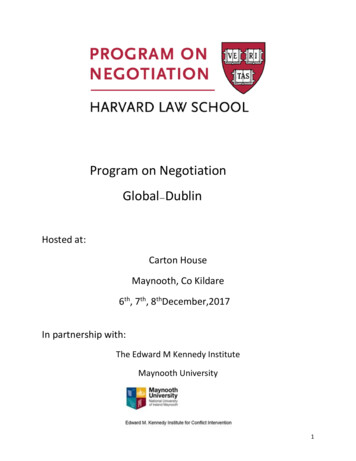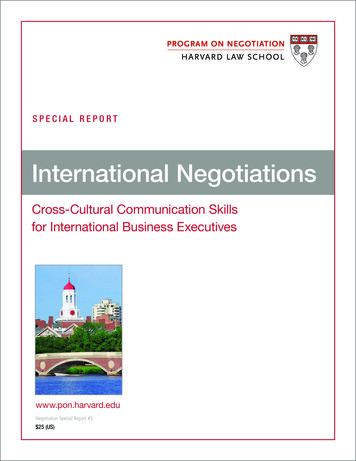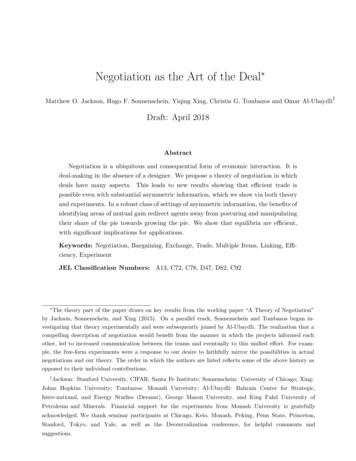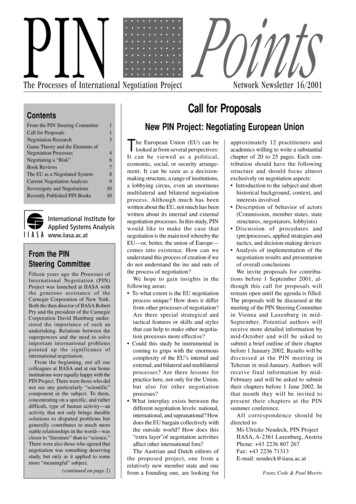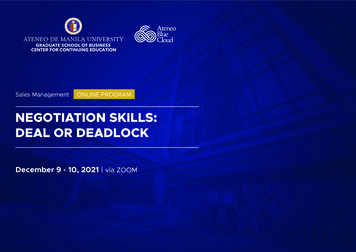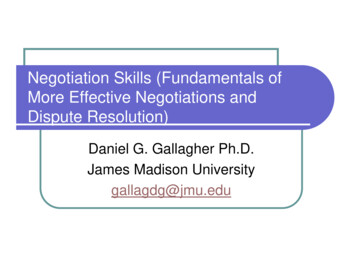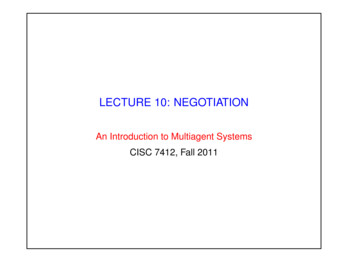
Transcription
Electronic Negotiation Support Systems and Their Role in Business CommunicationKöhneDissertational Thesis, accepted by the University of Hohenheim on 17 October 2007Faculty of Business, Economics and Social Sciences, Dean Prof. Dr. MüllerProf. Dr. Schoop, Chair of Information Systems IProf. Dr. Voeth, Chair of MarketingProf. Dr. Pfetsch, Chair of Communication Science and Media PoliticsFrank KöhneElectronic Negotiation SupportSystems and Their Role inBusiness CommunicationAn Exploratory Evaluation of Auction Use
-2-Through the unplanned sociocultural con sequences of technological progress, the humanspecies has challenged itself [.].This challenge can not be met with technologyalone. It is rather a question of [.] discussion.Jürgen Habermas (1970), Toward a Rational Society,Beacon Press, Boston, p. 61.
-3-Contents1. Introduction. 61.1 The Need for E-Negotiation Field Research. 61.2 Research Goals. 101.3 Structure of the Thesis. 112. A Review of Electronic Negotiation Support Research . 132.1 Subject of the Study – What is an Electronic Negotiation?. 132.2 Relevant Perspectives and Constructs . 152.2.1 Decision and Game Theory View. 16Normative Negotiation Analysis. 16Descriptive Negotiation Analysis. 17Prescriptive Negotiation Analysis. 17Critical Evaluation. 192.2.2 Social Science Perspective. 19Relationship and Networking Aspects of Business Negotiations. 19Operationalisation - The Social Capital Concept. 20Information Technology and Organisations. 21Critical Evaluation . 232.2.3 Communication and Media Theory View . 23The Communication Aspect of Business Negotiations. 23Media Effects in Negotiations. 26Critical Evaluation. 282.3 Electronic Negotiation Support. 292.3.1 Electronic Auction Research. 30The Electronic Auction Concept. 30Electronic Auction Applications. 33Empirical Research. 342.3.2 Negotiation Support Systems Research. 35The Negotiation Support System Approach. 35Negotiation Support System Applications. 35Empirical Research. 382.3.3 Negotiation Agent Research. 38The Negotiation Agent Approach. 38Negotiation Agent Applications. 40Empirical Research. 402.3.5 Methods of Electronic Negotiation Research . 412.4 Literature Review Conclusions . 432.4.1 Juxtaposition of Theoretical Perspectives. 432.4.2 An Integrated Perspective on Negotiation Support. 472.4.3 Existing ENS Research and Research Opportunities . 482.5 Deduction of Research Questions . 503. Methodology . 523.1 Epistemological Considerations. 52
-43.2 Selection of a Methodological Framework: the Grounded Theory Method. 563.3 An Introduction to the Grounded Theory Approach. 593.3.1 The Research Process. 59Data Collection. 59Data Analysis. 613.3.2 Critical Reflection of the Grounded Theory Method. 643.4 The Interview as a Data Collection Method. 663.5 Research Approach of the Present Study. 673.5.1 Time Frame of Analysis. 683.5.2 Selection of Data Sources. 683.5.3 Subject and Level of Analysis. 693.5.4 Initial Interview Blueprint. 704. Results - A Grounded Theory Field Study ofE-Auction Appropriation and Communicative Impact . 724.1 Steps of Inference and Inquiry. 734.2 Business Context Factors and the Roles of Negotiation Technology. 774.2.1 Communicative Setting of Electronic Business-to-Business Negotiations. 774.2.2 Operational Goals and Heuristics in E-Negotiation Behaviour. 814.3 Auction-based ENS as Process Tools. 834.3.1 The Process Tool Role and its Prevalence. 834.3.2 Antecedents of the Process Tool Role. 84Descriptiveness. 84Supplier Training . 86Trust and Transparency. 874.3.3 Consequences for Negotiation Processes. 89Re-Design in Adjacent Processes. 89Centralisation of Competencies in the Negotiating Organisations . 90Long-term Process Efficiencies. 924.3.4 Contingency Model of the Process Tool Role. 964.4 Auction Platforms as Communication Barriers . 974.4.1 Communicative Goals in Electronic Business Negotiations. 974.4.2 Theoretical References on Ideal Communication . 984.4.3 Identification of Communication Process Pathologies . 101Reciprocal Assumption of Rationality – A Common Understanding. 101Making and Questioning Validity Claims. 103Pragmatics in Negotiation Support Settings. 1054.4.4 Antecedents of the Communication Barrier Role . 107Technology Properties and Spirit – A Process View. 107Institutionalisation of Norms. 111Communicative Overconfidence in Electronic Negotiations. 1144.4.5 Consequences of the Communication Barrier Role . 117Inefficient Deals. 117Renegotiations . 120Missed Opportunities for Innovation and Collaboration. 123Model Combinations. 126Shift of Negotiator Roles. 1294.4.6 A Contingency Model of Communicative Impacts. 1314.5 ENS as a Business Relationship Threat: Not Technology Alone. 133
-54.5.1 The Relationship Threat Role of ENSs and its Prevalence. 1334.5.2 Antecedents of the Business Relationship Threat Perception of ENS Technologies. 134Media Structuration. 135Congruence of Relational Goals and Expectations. 136Rules of Conduct. 138Culture . 1404.5.3 Consequences of the Business Relationship Threat Role of ENS Technologies .141Social Capital Impacts. 141Intra-organisational Monitoring. 145Opportunistic Behaviour and Collusion. 146Dynamics of Relationship Shaping Moves. 1484.5.4 A Contingency Model of Relational Impacts. 1535. Discussion . 1555.1 A Theory of ENS Use and Effects. 1555.1.1 Hypotheses – An Overview. 1555.1.2 Revisiting the Research Questions. 1585.2 Critical Evaluation. 1605.2.1 Reliability and Validity . 1605.2.2 Potential Biases in the Dataset. 1615.2.3 On the Generalisability of the Theory. 1625.3 Research Opportunities. 1636. Summary. 1657. Implications . 1687.1 ENS Research Implications. 1687.1.1 Contextuality of ENS use - Does ENS Application Substitute Face-to-Face Interaction?. 1687.1.2 On the Technology Gap Between ENS Research and Practice. 1707.1.3 Process Integration and Technology Integration. 1717.2 Management Implications. 1727.2.1 On the Business Value of Discursiveness in E-Negotiations. 1727.2.2 On Electronic Auctions and Relational Strategies . 1747.2.3 Implications for the Supplier Side. 177Corporate Communication Management in Electronic Negotiation Settings. 177Proactive Technology Use. 1797.2.4 Implications for the Buyer Side - A Electronic Dialogue Sourcing Strategy . 180The Need for an Electronic Dialogue Sourcing Strategy. 181Components of an Electronic Dialogue Sourcing Strategy. 1817.3 Conclusion. 187Appendix – Field Notes Example. 188References . 191Abbreviation Reference. 206Index of Data Excerpts and Data References. 207Index of Illustrations . 208Index of Tables. 209
-6-1. IntroductionNegotiation is an omnipresent process across societies. Especially in high value transactionsamong business organisations, ordering from catalogues with fixed prices without some kind ofnegotiation is highly exceptional. The nature of business negotiation processes has changed funda mentally in recent years through the diffusion of electronic commerce.1.1 The Need for E-Negotiation Field ResearchAs the differentiation of products and services progresses while electronic communication mediaand electronic commerce mature, buyers are more intensively involved in processes of specifica tion and value creation. Examples are product and service customisation and integrated supplychains. Companies concentrate on core competencies while other product or service compon ents are acquired through procurement processes or other forms of collaboration. Yet these pro cesses take substantially less time than ever before. This is a consequence of the coordinatingeffect of Information Systems (IS), i.e. inter-organisational information technology and their socialenvironment of business processes and organisational change. It is illustrated through transactioncost reasoning in the seminal move to the middle hypothesis (Clemons et al. 1993, Bakos, Bryn jolfsson 1993). This hypothesis predicts a move towards long-term outsourcing relationships withsmaller sets of suppliers in reply to the move to the market hypothesis (Malone et al. 1987), whichalso predicts increased outsourcing in response to decreasing coordination costs, but underincreasing market competition.A study by BME1 and Siemens (2006, p. 11) draws an interesting picture regarding electronicsourcing and supplier relationship management systems in Germany: Only 17 percent of therespondents neither use Supplier Relationship Management (SRM) systems or e-procurement sys tems nor plan to do so. In other words, electronic Business-to-Business (B2B) transactions havebecome a matter of course. Only lately electronic commerce began to extend beyond the shop ping-cart metaphor. As the futurist Toffler (1980) sketched, the borders among numerous produ cers and consumers are partly blurring: More and more complex market transactions are conduc ted electronically and fast in dispersed, inter-organisational networks that transcend traditional1Bundesverband Materialwirtschaft, Einkauf und Logistik e. V., a German association dedicated to knowledge exchange, trainingand the development of standards in the field of business procurement and logistics.
-7-buyer-seller relationships in the sense of catalogue based buying and selling in many ways. Moreintensive, more frequent interaction and more flexibility in prices and service delivery areobserved.All of the developments sketched above require extensive negotiations rather than cataloguebased procurement processes. Contracts are changed more often, negotiation becomes evenmore frequent (Toffler 1980, p. 238).Many transactions are conducted in re-negotiation settings (Salacuse 2001), where an existingcontract is evaluated, re-discussed and possibly renewed, often through (e-) auction protocols(including requests for quotations, RfQs). On the background of these developments, the elec tronically mediated conduct of negotiations is a field that needs special attention both in researchand in practice for a number of reasons:1) First of all, it has long been documented that, from a rational point of view, people are inef fective negotiators and decision makers in general (see e.g. Bazerman et al. 2000, Kahneman,Tversky 1984, Simon 1957). They often fail to discover mutually beneficial solutions in a pro cess that often tends to be complex, time-consuming and emotionally laden. Given the omni presence and increasing importance of negotiation processes, any opportunity to diminishnegotiation inefficiencies is highly valuable.2) This brings up the issue of information technology impacts and organisational changes – anissue whose importance few researchers in the Information Systems field would question.However, the body of knowledge accumulated so far does not support reliable generalisations(Markus, Robey 1988). Hence, technology clusters need to be investigated individually.3) Through the recent developments in SRM, processes such as supplier selection and pricenegotiations are supposed to be streamlined in a way similar to what we have seen in opera tional fixed-price procurement processes based on catalogue solutions. However, these pro cesses are traditionally of a more strategic nature. There are critical statements regarding forexample the ethics of e-auctions or the fact that the low hanging fruits regarding savings areharvested already, making e-auctions appear less suitable as a long-term strategy (e. g. Han non 2003, Jap 2003, Emptoris Inc. 2005). Both points indicate the strategic relevance ofknowledge on E-Negotiation impacts.4) Existing research on electronic negotiations deals with automation and quantitative efficiencymeasures (i.e. prices or utility values) mainly, while more fundamental questions have been
-8-neglected so far (Ströbel 2000a), such as the actual use of negotiation support technologies,the determinants of successful use of such technologies and what successful use of such sys tems means. It will be argued that present negotiation support research is limited both interms of theoretical perspectives (see 2.2) and in terms of methods (see 2.3).5) Further, negotiation support technologies can be applied and understood in different waysand have not yet lost their interpretative flexibility. They possibly yield organisational andinter-organisational effects on transactions and relationships beyond the often claimed reduc tion of prices or transaction costs. Thus, they offer a rich area for inquiry.An exploratory survey study on business practices in trade negotiation processes, electronic aswell as non-electronic, was conducted in 2005 (Schoop et al. 2006b, Schoop et al. 2007a). It indic ates interesting inter-organisational effects: The rules of conduct in a procurement process suchas a priori commitments to award business and hard deadlines for offers, both constituting prop erties of electronic auctions, appear to systematically increase the likelihood of unplanned renegotiations. Thereby hidden, ex-post transaction costs seem to be introduced through a qualit ative component of E-Negotiation outcomes that is not quite understood taking a traditionalnegotiation theory point of view.Interestingly, a media richness argumentation, namely the idea that for example product spe cifications are deterministically oversimplified if communicated through inappropriately poorcommunication media, can not explain this effect (see also p. 26 on media effects). This area ofbusiness communication has a long tradition of exchanging textual offers, i.e. to communicatecomplex or ambiguous information through narrow channels. The causalities at work after theintroduction of electronic negotiation technologies seem to be more multi-faceted and contextu ally embedded than expected.The following example case, which we will revisit in the course of the thesis, illustrates someproblems of auction-based inter-organisational coordination. As the case was publicly discussed inthe media, it can be used here to illustrate the relevance and the context of the phenomenonunder study.
-9- Example Case: HypoVereinsbank 's Wealth Management customer magazineOn September 20, 2006 from 10:00 to 10:20 a German bank, the HypoVereinsbank, auctioned a service contracton the I-Faber electronic procurement platform. The contract covered the handling of a planned biannual customermagazine to be labelled Wealth Management through an advertising agency. However the (reverse) auction spe cification did mainly reveal that a customer magazine was to be produced. A detailed briefing, a common businesspractice in corporate publishing projects, or a set of strategic goals were not included. It was speculated that somebidders did receive a personal briefing.While details on the content of the specification package are not available, it is evident that the services to beprovided were specified only vaguely, while the process of interaction was specified in detail: All participants wereinvited via electronic mail. It further contained about 30 pages of auction principles and general terms and condi tions. Bidding was to be carried out via the platform exclusively. While the auctioneer specified a set of communica tion channels through which participants were meant to be available if needed, the auctioneer on the other handwould accept messages via certified (physical) mail exclusively. Participants were required to sign a general non-dis closure agreement covering all documents exchanged in the process.It should further be noted that the I-Faber platform, a subsidiary company of the Italy-based Unicredit group, whichin turn held a majority of shares of HypoVereinsbank at that time, is open only to registered suppliers, to whom aregistration fee applies. Technical training for the platform was not provided but is available commercially. The win ning bidder of I-Faber procurement auctions is charged a transaction fee based on transaction volume.In this case a winning bidder was determined by the system. Shortly after, disregarding the decision rules establishedbeforehand, the bank invited a group of bidders for further, open ended negotiations.The case generated a lot of publicity. Especially advertising agencies and spokespersons of the marketing com munity criticised both this particular procurement process as well as the general idea of reverse-auctioning suchservices online, because that would imply a similar strategic value of their work as for example office supplies orother indirect goods. It further disregards existing business relationships and the specific, creative role of marketingagencies and customer's interaction with such agencies.2While some flaws of this case are evident, it is unclear what the general effects of electronic nego tiation in practice really are and which model of negotiation is appropriate for which businessscenario.There is currently a general lack of empirical field work in the area of negotiation support,mainly for two reasons: Firstly, negotiation data and negotiation skills are valuable strategic assets.2This summary was collected and translated from the corporate publishing press by the author using the following sources:Hermes 2006,http://www.onetoone.de/index.php?we objectID NewsInhalt.php?id 911http://werbewoche.ch/newsmail060917 hypoverein.werbewoche?ActiveID 2007http://www.cp-wissen.de/news/auktion.html, each last accessed 2007-07-29.
- 10 -Therefore, non-disclosure agreements are often in place and it is thus difficult for researchers togain access to field data. This is even more problematic in cases that were not successful for obvi ous reasons, although these are especially interesting from a researcher's point of view.Secondly, companies began only recently to conduct complex negotiations electronically interms of regular business practice – the use of reverse auctions et cetera is no longer experi mental or driven by a hype. Hence, these technologies can now be meaningfully investigated inuse. Further, companies begin to use more sophisticated multi-attribute Internet based procure ment auctions, or a dedicated negotiation support system (NSS) such as SmartSettle 3 (Thiessen,Soberg 2003) or collaborative functionality in electronic marketplaces (e.g. SupplyOn) in order toovercome the limitations of fixed price electronic commerce with homogeneous goods and ser vices.1.2 Research GoalsThe situation sketched clearly shows the need for empirical field research on the use and effectsof electronic negotiation support technologies. Since the electronic reverse auction paradigm isthe dominant type of electronic negotiation in practic
non 2003, Jap 2003, Emptoris Inc. 2005). Both points indicate the strategic relevance of knowledge on E-Negotiation impacts. 4) Existing research on electronic negotiations deals with automation and quantitative efficiency measures (i.e. prices or utility values) mainly, while more fundamental questions have been
